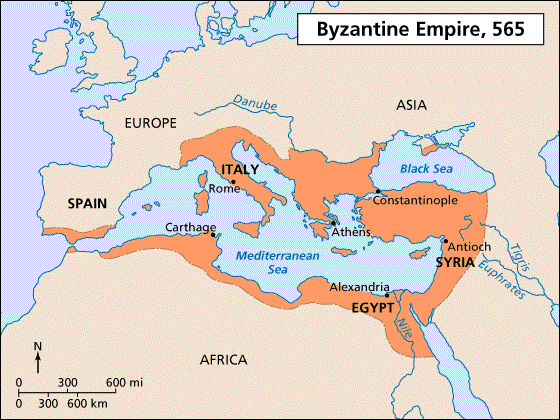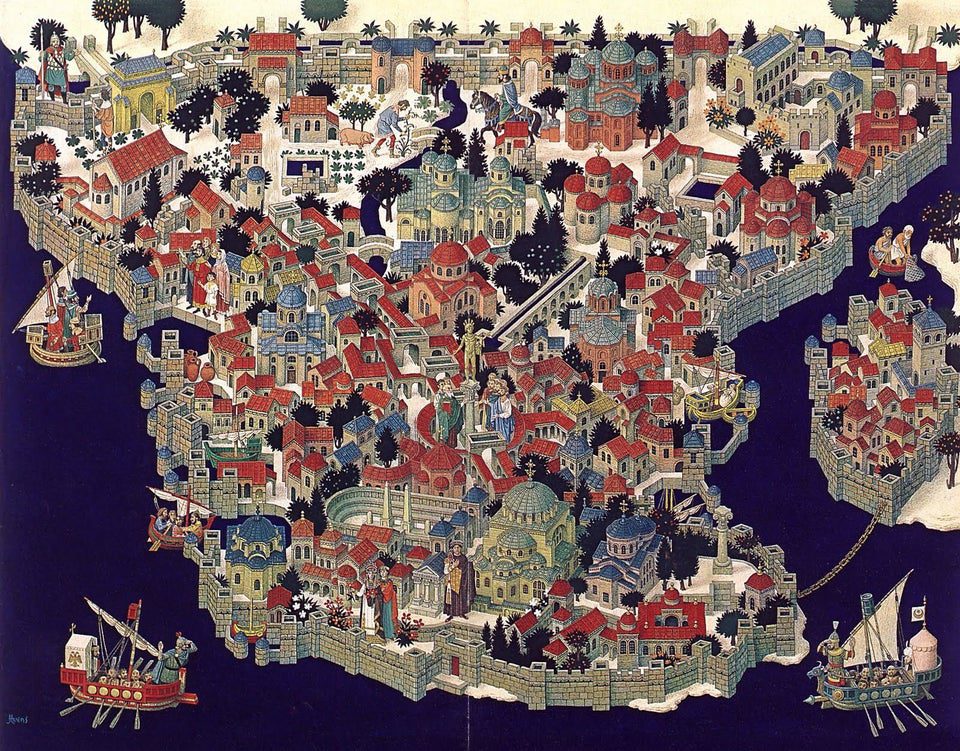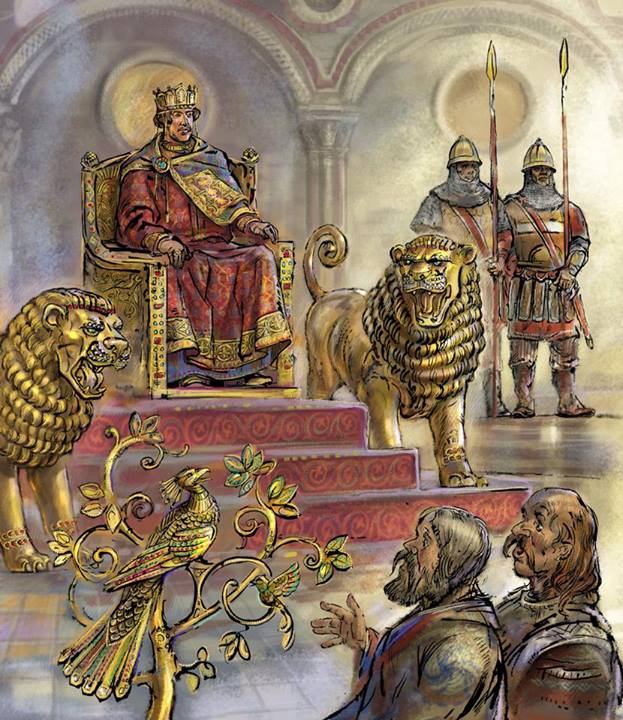Byzantine diplomacy: The elixir of longevity
Visit the other stops on our journey:
The term ‘Byzantine’ comes from the name of the ancient Greek city Byzantium which the Roman Emperor Constantine I (Constantine the Great) rebuilt and renamed Constantinople (present-day Istanbul), and in 330, moved the capital of the Roman Empire from Rome to Constantinople. Situated on the Bosporus (part of the boundary between Europe and Asia), the city's location ensured that it could be supplied from the sea in the event of a siege.
The tale of the founding of Byzantium speaks about its favourable position. According to the legend, the ancient Greek prince Byzas consulted the oracle of Delphi on where to establish a new colony. The oracle instructed him to settle opposite the ‘land of the blind’. When he arrived at where the Sea of Marmara meets the Bosporus, on the border of Europe and Asia, he understood the meaning of the oracle. Opposite of him was the Chalcedon colony in Asia Minor, whose inhabitants he considered 'blind' as they did not see the advantages of the European shore. In 667 BC, Byzas founded the city of Byzantium.

Roman diplomacy: Eastern Roman Empire
The Byzantine Empire (395–1204 and 1261–1453), also known as the Eastern Roman Empire, was known to its inhabitants as the ‘Roman Empire’ or the ‘Empire of the Romans’, even after the fall of the Western Roman Empire in 476. During its golden period in the 6th century under Emperor Justinian, this empire covered much of the land surrounding the Mediterranean Sea, including what is now Italy, Greece, and Turkey, along with portions of North Africa and the Middle East.

Byzantine diplomacy: Highlights
One of the most impressive achievements of the Byzantine Empire was its longevity (330–1453), and it remains one of the longest lasting social organisations in history. The empire survived through adaptation, and its backbone was its administration. It managed to adapt to the frequent changes of rulers and continuous crises on its borders. With relatively limited military force, diplomacy was crucial for its survival.

Constantinople. Illustration by Juan-Leon Huens
Diplomacy was a necessity because it had enemies along its long borders which could not be protected by its limited military strength. Thus, one of the golden rules of the Byzantine elite was to avoid wars at almost all costs. Byzantine rulers were fully aware that, even with an occasional victory, the empire would lose in the long term if it engaged in military conflicts. Wars were expensive even then, and cost much more than bribing the enemy or finding a resolution to a conflict.
Byzantine diplomacy: Inherited practices
The Byzantine period was probably the most important in the history of diplomacy. Today it is seen as the bridge between ancient and modern diplomacy. The empire was both a practitioner of the practices from ancient Mesopotamia, Egypt, Greece, and Rome and an innovator of new practices which were passed on to our time via Venice and the diplomacy of Renaissance Italy.
Byzantine diplomacy applied the following practices of the ancient civilisations:
- Diplomacy of ancient Near East (Mesopotamia, Egypt, Persia): elaborate protocol and ceremonies, dynastic marriage to cement an alliance, trade diplomacy by merchant ambassadors
- Ancient Greek diplomacy: the use of rhetoric as a tool of public diplomacy (although Byzantine envoys relied far less on oratory than those dispatched by the Greek city-states)
- Roman Empire: divide and conquer tactics, using civil-engineering projects to impress foreigners
Byzantine diplomacy: Innovations
A proto ministry of foreign affairs
In the Byzantine Empire, diplomacy evolved from ad-hoc to organised government activities through its 'Office of Barbarian Affairs'. The term 'barbarian' referred to all foreigners, thus the office could be understood as the 'office of foreign affairs'. The office housed numerous interpreters and translators, and similar to a modern ministry of foreign affairs, it prepared Byzantine envoys for missions abroad, analysed reports which arrived from envoys, organised visits of foreign dignitaries to Constantinople, prepared international treaties, etc. The office established archives as a way to preserve institutional memory. Unlike modern diplomacy, Byzantine did not have permanent diplomatic missions. Envoys were sent abroad in order to deal with specific issues, even when they took several years to solve.
Soft power, public diplomacy, and protocol
The Byzantines realised early on the importance of winning the hearts and minds of their neighbours. Whenever possible, the empire turned neighbours from potential enemies to allies and friends. Their public diplomacy toolkit included: the conversion of nomadic tribes (especially Slavs) to Christianity, the use of ceremonies for impressing foreign dignitaries, and the education of future neighbouring rulers in Constantinople’s leading schools. Some of these public diplomacy techniques are still in use today. The empire particularly excelled in the use of protocol and ceremonies with the aim to impress foreign dignitaries, as the location and civil-engineering of Constantinople (e.g. Hagia Sophia and the Hippodrome of Constantinople) remain impressive even today.
The Byzantine emperor received foreigners in the Magnaura, where he sat on an automated golden throne surrounded by golden lions that roared and golden birds that tweeted. A special hydraulic system elevated the throne to the ceiling, making a lasting impression on visitors. The Book of Ceremonies, compiled by Constantine VII (945–959), describes court rituals, seating arrangements, and other protocol details.

The Golden Automata of the throne room. Source: camerainthesun.com.
Introduction of regular diplomatic reporting
Envoys had an obligation to send written diplomatic reports back to Constantinople. The reports were archived in the office of barbarian affairs. The content of the diplomatic reports was not very different from modern diplomatic reports, as we could see from WikiLeaks' diplomatic reports and cables. They dealt with local political developments, the personalities of leaders, analysis of power struggle, etc.
Proto intelligence service
Access to information was central to Byzantine diplomacy. In order to obtain the right information, the empire founded the first intelligence service, consisting of a network of official and unofficial agents (including merchants, missionaries, and military officers) who were sent abroad. In order to ensure secure communication, they further enhanced the Caesar cipher encryption technique.
Early multistakeholder diplomacy
The Byzantine Empire used the services of merchants, priests, and other citizens who travelled abroad. All of them served as Byzantine diplomats, and had a duty to report back to Constantinople from their travels. In this way, Byzantine diplomacy managed to achieve the difficult task of maintaining a huge empire with very limited military power and financial resources.
Early international law
The Byzantines signed international treaties with neighbouring tribes, although these were framed as unilateral decrees since the emperor claimed to be the ruler of the whole world.
In the long term, the empire benefited from introducing predictable and legal relations with otherwise unruly tribes on its borders. Even when it had to go to war, it tried to find legal justifications such as the concept of 'just war' (reclaiming lost territories or defending the empire). The introduction of a legal aspect to relations with foreigners had an important impact on developing more civilised relations in Europe and the Mediterranean. In some cases, adherence to legality restricted room for manoeuvring for the otherwise very pragmatic Byzantines, but even in these situations, they avoided breaking the rules. They employed a very complex interpretation of treaties in order to justify their actions in accordance with signed treaties, making them masters of interpretation and constructive ambiguities.
Mastering time management
Time always played an important role in the Byzantine Empire. During its 1,123 years of existence, the empire preserved many distinctive features, including the way it conducted diplomacy. Byzantine diplomacy mastered the use of time in its activities. In most cases, playing the waiting game was in Byzantine’s best interest. With stable institutions, Byzantines were always ahead of nomadic tribes, which were easily affected by disease and the weather. Thus, in times of conflict, the smart approach was to let time pass in order to defuse tension and choose the right moment for counter-action.
Byzantine communication and technology
Byzantine contributions to technology, philosophy, science, art, and architecture are numerous, and include both inventions and innovations.
Communication
Communication across the expanses of the empire was necessary for both diplomacy and administration. During the 9th century, the Byzantines used a system of beacons during the Arab–Byzantine wars to transmit messages from the border with the Arab caliphate, across Asia Minor, to Constantinople. The system was devised by Leo the Mathematician during the reign of Emperor Theophilos (829–842). The main line of beacons stretched over some 450 miles and functioned through two identical water clocks placed at two terminal stations.
The rise of Rome from a small city-state into a vast empire required reliable and speedy communications with the governors of distant provinces. This need was met by the cursus publicus, the courier service of the Roman empire and the most developed postal system of the ancient world. The relay stages (established at convenient intervals along the great roads of the empire) formed an integral part of its complex military and administrative system. The speed with which messengers were able to travel was not to be rivalled in Europe until the 19th century: it is claimed that more than 270 km could be covered in a day and a night.
Warfare
Greek fire played a crucial role in the defence of the empire against the early attack of the Muslim Arabs. Invented by Callinicus, Greek fire was a naval weapon resembling the modern flamethrower, and used to set fire to enemy ships. The exact composition was a well-guarded state secret.
The hand-trebuchet, a staff sling mounted on a pole using a lever mechanism to propel projectiles, was used by Emperor Nicephorus Phocas’ army in his campaigns to disrupt enemy lines.
The counterweight trebuchet, which was far more powerful than the normal traction trebuchet, was used by Emperor Alexios I Komnenos, and it's said that it impressed his crusader allies during the siege of Nicaea.
Architecture
The Byzantines developed new forms in architecture:
- Cross-in-square layout: Buildings with a square centre and an internal structure shaped like a cross and topped by a dome. This layout was used in Greek Orthodox churches for 1,000 years.
- Pendentive dome: A circular dome placed over a square room. The first (and most famous) example of a pendentive dome is Hagia Sophia, designed by Isidore of Miletus.
- Pointed arch bridge: A bridge resting on a pointed arch. It appeared in the 5th century.
Daily life
The Justinian Code or Corpus Juris Civilis was a collection of legal rulings from previous centuries, and an agreement to form a definitive body of law. The Byzantine Empire continued the Roman legal tradition, while making its own revisions.
Due to the ideals of Christian charity, Byzantines built hospitals, i.e. general and permanent spaces for medical care. After the first Council of Nicea in 325, headed by Constantine I, their construction began in every place that had a cathedral.
Ship mills were introduced by General Belisarius during the Siege of Rome (537/538) as the Ostrogoths had cut off the water supply by aqueducts. A ship mill is a watermill built on a floating platform or ship. The passage of the water turns the wheel and this then produces a force that can be applied to grinding wheat.
From Byzantine to modern diplomacy
Many core elements of Byzantine diplomacy exist even today. They were passed on to the modern era via the Italian city-states – mainly Venice. For example, Italian city-states established the first permanent embassies.
From Italy, the way of running diplomacy moved to emerging European national states. France created the first formal ministry of foreign affairs in the 17th century, and other European states followed. When we remove the trappings of our time, we can see that – in essence – many tools of Byzantine diplomacy are still in use today.
Lessons for our time
What are the lessons that we can learn from Byzantine diplomacy?
- Time management: Successful diplomacy requires consistent efforts over a long period of time. Diplomacy requires time, which is in opposition with our continuous need for immediate action.
- The centrality of information: The Byzantines realised the importance of knowing what's happening abroad, and they used this information to control neighbouring tribes for over 1,000 years. The advancement of technology, and especially the internet industry, has brought a significant asymmetry with the rest of the players in the policy field.
- Gradual innovation: The Byzantines learned new techniques, collected feedback, and then included it in their revisions. They were masters of the Gartner hype circle, and understood the phases of emerging ideas.
- Don't forget the basics: We always need to remember the purpose of diplomatic work. In the case of the Byzantines, it was the survival of the empire. Despite numerous difficulties, they managed to last over 1,000 years.
Today, the adjective ‘byzantine’ is sometimes used to describe a devious and usually surreptitious manner of operation: intrigue, plotting, and bribing. Still, historical records show that Byzantine politics were morally neither worse nor better than politics in previous or later years. In the end, their diplomacy served the Byzantines well.
Byzantine served as a buffer zone between Europe and nations from Central Asia and the Middle East. By resisting attacks and skilfully integrating new peoples (e.g. Slavs, Arabs, Turks), the Byzantine Empire gave Europe time to recover from plagues and wars.
Meanwhile in Asia ...
In the 13th century, the largest contiguous land empire in history was growing in East Asia: the Mongol Empire.
The Mongol Empire emerged from the unification of nomadic tribes in present-day Mongolia under the leadership of Genghis Khan who ruled 1206–1227. Setting on numerous ferocious military campaigns, he spread his rule from Korea to the Caspian Sea, while his successors continued the expansion, reaching Poland and Asia Minor in the west and conquering the whole of China.
A major Mongol contribution was that they built trade routes across Eurasia, including the famous Silk Road on which Marco Polo travelled. The routes were safe and well maintained, ushering in an era of great exchange between the West and the East.
The Mongols were open to various influences, practiced religious tolerance, merit over birth, and equality before the law. Their approach to diplomacy was also open: in contact with other nations, the empire employed specialised personnel who knew how to adapt to the cultural frameworks of others. The aim of Mongol diplomacy was to set up a network of more or less formal dependencies.
In short, the rules of this vast empire were fairly simple: surrender, be loyal, and enjoy privileges – or perish.
Cheers! Here's to wine
The drink of the Byzantine Empire was wine. The original Byzantines were considered to be the foremost wine-drinkers (oenophiles) of the ancient world. It was said they could not bear the sound of the war trumpet even in their dreams, as their ears were accustomed to the sound of flutes at drinking parties. In medieval times, both Constantinople and the empire itself were viewed as a place where wine flowed freely, and since then we have the proverb ‘Byzantium conquers all with its wine’. Monasteries and the Church were catalysts both for the dissemination and Christianisation of the wine culture, as well as for the evolution of the symposia (drinking parties) of the ancient world into more morally acceptable forms of wine consumption.

Noah drinking wine, Mosaic in the Baptistery of St, Mark's Basilica.
Source: prisma
A number of Byzantine provinces were renowned for their sweet, aromatic wines, in particular Bithynia. Many celebrated wines from the early Byzantine period came from Syria, Palestine, Carthage, Egypt, the Aegean islands, the Peloponnese, and Italy.
Wine was a key part of the Byzantine diet. The average Byzantine adult male drank about a litre of wine per day. Women would drink about 0.5 litres of wine per day, and children a bit less, so the average family consumed about two litres a day, and a city the size of Antioch (c. 150,000 citizens) needed around 15 million litres of wine per year.
Why was wine so important?
It was a terrific source of calories, 40–80 grams of carbs per litre, so adult males were getting 160–320 calories from their wine: about the same as eating a burger. Plus, it's full of nutrients, particularly potassium and vitamin C. In an age when disease was endemic, the nutrients in wine helped replenish those lost to diarrhoea. It was also safer to drink than most sources of water.
People who couldn't afford wine drank ‘posca’, a drink made by mixing vinegar, water, and perhaps herbs. It was actually a wine gone sour, possibly mixed with sweeteners or other flavours to make it taste better (we don't really know). It was drunk by soldiers, the lower class, and slaves. The advantage was that it had already gone bad, so it had a pretty stable shelf life for shipping into cities or out to distant military posts.
You can reference this text as
Jovan Kurbalija, Byzantine diplomacy: The elixir of longevity, 'Diplomacy and Technology: A historical journey', 2021, DiploFoundation
Listen to the podcast, or watch the recording of our May Masterclass Byzantine diplomacy: The elixir of longevity. Consult the PPT presentation.
Recordings from all sessions are available on our YouTube channel.
[Podcast]
[Recording]

For more information on this topic, you can consult the following resources:
The Cambridge History of the Byzantine Empire
Edited by Jonathan Shepard, Cambridge University Press, 2009
Byzantium lasted a thousand years, ruled to the end by self-styled 'emperors of the Romans'. It underwent kaleidoscopic territorial and structural changes, yet recovered repeatedly from disaster: even after the near-impregnable Constantinople fell in 1204, variant forms of the empire reconstituted themselves. The Cambridge History of the Byzantine Empire tells the story, tracing political and military events, religious controversies and economic change. It offers clear, authoritative chapters on the main events and periods, with more detailed chapters on particular outlying regions, neighbouring powers or aspects of Byzantium.
The History of Byzantium - A podcast telling the story of the Roman Empire from 476 AD to 1453
“The History of Byzantium” is a podcast dedicated to the story of the Roman Empire from the collapse of the West in 476 to the fall of Constantinople in 1453. Byzantine history is fascinating, world changing, and largely forgotten. Listen and discover who they were.
‘Diplomacy, Byzantine’, in Dictionary of the Middle Ages, vol. 4, p. 193-197
Author: Wozniak, Frank E., Charles Scribner's Sons, New York, 1984
The Empire That Would Not Die - The Paradox of Eastern Roman Survival
Author: John Haldon, Harvard University Press, 2016
The eastern Roman Empire was the largest state in western Eurasia in the sixth century. Only a century later, it was a fraction of its former size. Surrounded by enemies, ravaged by warfare and disease, the empire seemed destined to collapse. Yet it did not die. In this holistic analysis, John Haldon elucidates the factors that allowed the eastern Roman Empire to survive against all odds into the eighth century.
A History of the Byzantine State and Society
Author: Warren Treadgold, Stanford University Press, 1997
This is the first comprehensive and up-to-date history of Byzantium to appear in almost sixty years, and the first ever to cover both the Byzantine state and Byzantine society. It begins in A.D. 285, when the emperor Diocletian separated what became Byzantium from the western Roman Empire, and ends in 1461, when the last Byzantine outposts fell to the Ottoman Turks.
The Grand Strategy of the Byzantine Empire
Author: Edward N. Luttwak, Harvard University Press, 2011
In this book, the distinguished writer Edward N. Luttwak presents the grand strategy of the eastern Roman empire we know as Byzantine, which lasted more than twice as long as the more familiar western Roman empire, eight hundred years by the shortest definition. This extraordinary endurance is all the more remarkable because the Byzantine empire was favored neither by geography nor by military preponderance. Yet it was the western empire that dissolved during the fifth century. The Byzantine empire so greatly outlasted its western counterpart because its rulers were able to adapt strategically to diminished circumstances, by devising new ways of coping with successive enemies. It relied less on military strength and more on persuasion—to recruit allies, dissuade threatening neighbors, and manipulate potential enemies into attacking one another instead.
The Grand Strategy of the Byzantine Empire is a broad, interpretive account of Byzantine strategy, intelligence, and diplomacy over the course of eight centuries.
Soft and hard power of Byzantine diplomacy
[Interview with Prof. Jonathan Shepard]
What were the tactics of Byzantine diplomacy? How did it last for over 1,000 years? Prof. Kurbalija discussed these topics with Prof. Jonathan Shepard, in the podcast interview.
Prof. Shepard received his doctorate in 1973 from Oxford University and was a lecturer in Russian History at the University of Cambridge. He was co-author of The Emergence of Rus (London, 1996) with Simon Franklin, with whom he also edited Byzantine Diplomacy (Aldershot, 1992). Edited volumes include The Expansion of Orthodox Europe (Aldershot, 2007) and The Cambridge History of the Byzantine Empire (Cambridge, 2008). Has published over 100 articles on subjects ranging from Anglo-Saxon settlements on the Black Sea to the First Crusade; In 2011 he published a collection of these in Emergent Elites and Byzantium in the Balkans and East-Central Europe.
Browse through the curated list of videos related to Byzantine life and history.







